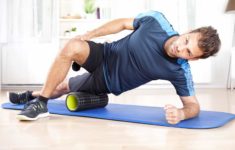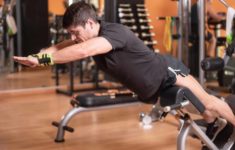If you are looking to spice up your training routine, the duck walk is one of the exercises you should consider adding to your program. It is one of the most challenging but highly beneficial movements that you can do without equipment.
The duck walk provides all the benefits of bodyweight squatting and amplifies them for more desirable results. It keeps you in a squatting stance for the entire set, maximising its effects on the muscles involved. [1].
Below, we have some tips to help you learn what this exercise is and how to do it correctly.
Table of Contents
Key Takeaways
- The duck walk is a squatting variation that increases tension to the lower body during exercise.
- During a duck walk exercise, maintaining the squatting form while walking gives you the optimal burn and will improve your endurance.
- The duck walk is an excellent exercise to work your glutes, quads, calves, and hip flexors.
What Are Duck Walks?
Duck walks are a variation of the basic squat. As the name suggests, this exercise requires you to walk in a crouch or a full squat position, taking the walking style of a duck. The activity is designed to help you improve stamina.
The exercise is mobility and warm-up activity for the sides, back, and ankles. In simpler terms, it targets the lower half of your body, creating tension in the muscles during movement. It is also a great fat burner and will help you lose weight (and gain strength in the process).
How To Do The Duck Walk Exercise
If you are new to this exercise, below, you will find a step-by-step guide on how to do it correctly.
Step By Step – Duck Walk
Starting Position
Stand with your feet shoulder-width apart. This posture ensures an adequate distance between your legs for a deep squat without straining your kneecaps, calves, and ankles.
Make sure your feet are pointed slightly outward and your knees are fluid and in a neutral form.
Execution
Start with a squat position and bend your knees to lower your hips down. Push your hips back, pretending you are about to sit on a chair. This posture will give you the ultimate burn.
Go as deep as you can, ensuring you keep a straight spine. Keep your toes and heels flat to maintain the proper form for this exercise. Spreading your arms in front of you will help you to balance better.
Take a step forward with one foot keeping your hips the same distance from the floor. Make sure you land with a flat foot on the floor and do the same with the other foot. Also, keep your chest in a neutral forward posture without arching the back.
Repeat the movement and move a few steps forward. Reverse and walk backward to take the starting position with your arms spread out.
If you are a beginner, you should focus on doing the exercise slowly while keeping the correct posture. As you get used to the movement, add a few weights and do the workout. This will add a little more tension to your muscles for more challenging workouts.
Safety Tips
When doing the duck walk, ensure you warm up and cool down after. This exercise engages large lower body muscles, hence the need to warm up. Warming up will help prevent injuries.
Ensure you stand with your toes flat and heels on the floor with the chest forward when doing the exercise. Also, maintain the distance between the hip and the floors when walking. If you feel pain, stop.
FAQ
What Muscles Does The Duck Walk Target?
If you learn to walk like a duck, you will build strength in your legs. The duck walk targets some of the largest muscles of your lower half of the body. These are:
- Quadriceps. These are the front muscles of your thighs, responsible for extending your knee. The four separate ones are the cactus lateralis, the vastus intermedius, the vastus medialis, and the rectus femoris.
- Calves. These are the back muscles of your leg between the heel and the knee. These are responsible for plantar flexion to point your toes. When you jump, run or leap, these muscles are activated.
- Glutes. These are the butt muscles responsible for extending the sides, drawing your thighs outwards, and rotating the leg. These are the gluteus minimus, gluteus maximus and gluteus medius.
Is The Duck Walk Exercise Good For You?
Yes, this exercise is helpful in strengthening your hip flexors. These connect your legs to your trunk, essential for walking and lifting your legs. It is also an ideal workout to incorporate into your weight loss program.
The duck walk engages the core during movement. A strong core is essential for balance, posture, and proper movements in fitness [2].
Whether you are running or carrying your child, a strong core helps with stability. Incorporating this exercise into your fitness routine can help prevent injuries [3].
The exercise also boosts your glutes, specifically the gluteus maximus. This muscle is powerful and allows you to hunch and lift heavy objects. These grow with the routine, eventually growing your butt.
Why Should the Feet Be Shoulder Width Apart To Do A Duck Walk?
The shoulder-width apart position helps to align your body in a neutral posture. It ensures you can move each part of the body seamlessly without straining the other.
For a duck walk especially, the shoulder-width position helps you go down and keep at it without hurting your knees and ankles. It also ensures your shoulders align with your sides, essential for keeping the correct posture during the exercise.
The Bottom Line
A duck walk exercise is an excellent addition to your exercises, thanks to the multiple muscles it works on. It can help you improve strength and grow muscle in your thighs, sides, butt, and lower parts of your body.
This exercise is ideal for both beginners and advanced fitness enthusiasts. With the variation, you can add weight; it can be an excellent exercise for both strength training and weight loss.
References
- https://www.health.harvard.edu/staying-healthy/the-lowdown-on-squats
- https://www.mayoclinic.org/healthy-lifestyle/fitness/in-depth/core-exercises/art-20044751
- https://www.ncbi.nlm.nih.gov/pmc/articles/PMC3806175/






